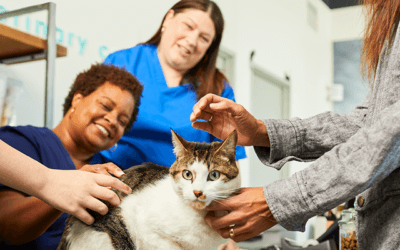For veterinary practices, many challenges have surfaced over the last two years, and some have been exacerbated. One, however, has been consistent regardless of demographics, geographical location, or industry: staffing shortages and rising compensation.
“Economists say changing demographics like aging, and retiring workers are a factor behind the shortages, as well as border controls and immigration limits, and demands for better pay and flexible working arrangements.” – CNBC.com [1]
We’ve discussed it and stressed over it, but what can we do about it? In such a challenging time, when businesses — even veterinary practices — are adjusting their hours due to staffing shortages, it’s time to understand what the future of the labor challenges will look like.
Here are some statistics and observations to begin the conversation:
 The 2022 Cost of Living Adjustment (COLA) from the Social Security Administration is 5.9%, which is the highest it’s been since 1982.[2]
The 2022 Cost of Living Adjustment (COLA) from the Social Security Administration is 5.9%, which is the highest it’s been since 1982.[2]- 24 states are raising their minimum wage in 2022.[3]
- The federal government is attempting to pass a federal minimum wage of $15/hr.
- Many other industries (fast food, restaurants, hotels, etc.) have already adopted a $15/hr minimum compensation.
- Clients are less price-sensitive than they have ever been, due to supply:demand with appointment availability and wait times.
Veterinary practices vs. staffing and compensation crisis
How can we get ahead of the current (and upcoming) challenges? One challenge is getting applicants to even apply, but what can be instantly controlled is how competitive you are with your compensation ranges.
Example:
 ABC Animal Hospital has an annual revenue of $2million per year and an initiative to have a $15/hr minimum wage over the next 5 years. Currently, their minimum compensation is $10/hr. They would like to raise their minimum up to $12/hr to try to stay more competitive with the industry trends. They would like to increase each staff member an average of $2/hr, and make their minimum compensation $12/hr. They have projected, based on current staff and hours, that this will be an increase of $100k annually in payroll.
ABC Animal Hospital has an annual revenue of $2million per year and an initiative to have a $15/hr minimum wage over the next 5 years. Currently, their minimum compensation is $10/hr. They would like to raise their minimum up to $12/hr to try to stay more competitive with the industry trends. They would like to increase each staff member an average of $2/hr, and make their minimum compensation $12/hr. They have projected, based on current staff and hours, that this will be an increase of $100k annually in payroll.
PRO TIP: Culturally, it is very important to not offer new hires more than you are paying your current team members with similar skills/background/experience. For example, you just hired someone entry-level at $10/hr, and you are about to hire another entry-level employee at $12/hr without raising your other employee.
Solutions to the crisis
1. Across-the-board increase
One approach is an across-the-board increase in current prices, to compensate for the increase in payroll. For a $2million practice, an increase in payroll of $100k would translate to a 5% increase in prices across the board.
$100,000 / $2,000,000 = 5%
While a 5% increase may seem like a big increase to some that do not routinely do them, remember a few things:
- There are supplies (gauze, catheters, syringes, etc.) that have gone up in cost, some more significant than others. If you have not adjusted your professional services to accommodate these increased expenses then you are less profitable than you used to be
- For a practice that has an average client transaction of $175, a 5% increase means that, on average, each client will be paying $8.75 more per transaction. Put in perspective, that is not a large amount for each client to pay in order to be more competitive with your compensation.
2. Strategic increase
Rather than an across-the-board increase, there may be some codes you wish to increase more while not increasing others. For example, if you’d rather not increase your vaccines and exam fees, you can choose to raise other codes more that are less likely to cause price sensitivity.
Consider a high-volume code like an intestinal parasite exam. If your current charge is $25, a 5% increase on that would be $1.25. Knowing that the benchmark is $32[4], you choose to raise it $7 which is a 28% increase. Due to the high-volume nature of this code, it will make up for some of the lack of increase in vaccines and exam fees.
Analyzing higher volume codes, for more aggressive price increase opportunities, can be a strategic approach to covering the increased payroll of your compensation normalization.
The model that is used can then be incorporated into a plan for future compensation normalization. Regardless of the approach, DVMs on production will see an increase in compensation potential, based on compensation structure. For associates that are not on a production or base+production model, an increase in salary/hourly compensation should be considered.
A strategic approach to combat the staffing and compensation crisis
 The goal of this strategic approach to compensation normalization is to be more competitive with pay, without pricing yourself out of the market.
The goal of this strategic approach to compensation normalization is to be more competitive with pay, without pricing yourself out of the market.
However, many practices that I have worked with have a huge revenue opportunity just by raising prices up to the industry benchmarks; which are simply averages. Even if there are codes that are not touched due to price sensitivity concerns, other codes can be raised more. It’s not about price-gouging clients, it’s about charging a fair price for services rendered, and staying competitive in the current (and foreseeable) employee shortage. It’s hard to generate revenue, and support our clients in need, without fairly compensated employees.
REFERENCES



